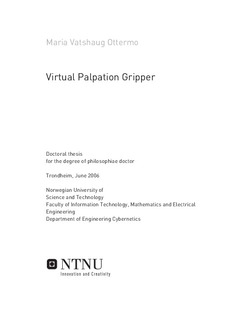| dc.description.abstract | This thesis presents the design and performance of the Virtual Palpation Gripper, an early prototype of a remote palpation instrument intended for laparoscopic surgery. Psychophysical experiments related to this prototype are also described.
In minimally invasive techniques, such as laparoscopic surgery, the interventions are performed with instruments inserted into the body through small incisions. This technique has become increasingly popular and is now considered the gold standard for many surgical procedures, such as cholecystectomy. Themain advantages compared to open surgery are smaller scars, reduction in pain and faster recovery. Despite the advantages, laparoscopic surgery introduces many restrictions for the surgeon, such as reduced dexterity, fewer degrees of freedom and awkward positioning of the hands. Additionally, the visual and tactile perception is severely degraded. The aim of the Virtual Palpation Gripper is to compensate for some of the lost perception by feeding tactile information back to the surgeon. The ultimate goal is to make the remote palpation instrument serve as an extension of the surgeon’s fingers. This is accomplished by attaching a tactile sensor array to the end effector of a laparoscopic grasper and a tactile display to the handle of the grasper. The sensor array then aids as the tactile sense, and the tactile information is sent to the surgeon’s fingers via the tactile display to provide him with a feeling of the shape,hardness, or size of an object grasped with the laparoscopic instrument.
Two different sensor arrays are discussed. The first one is based on piezoelectricity and is made from scratch in our laboratory. The second sensor is the custom made TactArray, which is based on a mature capacitive technology. Both sensor arrays are small enough to fit through a 12 mm trocar. Due to crosstalk in the piezoelectric array, the TactArray sensor array is chosen for the prototype of the Virtual Palpation Gripper. The performance and usefulness of the sensor array is tested and documented through an experiment where 15 surgeons with varying experience participate. The main goal is to compare direct palpation (with gloved fingers as in open surgery), palpation with a conventional laparoscopic grasper and palpation with a laparoscopic grasper with visually presented tactile information. Results show that direct palpation is superior to both the laparoscopic graspers, but that the grasper with visual feedback of the tactile image seems to be useful for subjects who fully understand how to use it, especially for hardness discrimination (note that the size of the end effector of the conventional grasper and the quality of the grasper differed from that of the laparoscopic grasper with visual feedback of the tactile image, and this may have affected the results).
The tactile shape display consists of small direct-current motors and has a size compatible with conventional laparoscopic instruments. Performance tests of the display are conducted with focus on positioning accuracy, force, bandwidth and stiffness. In addition, an experiment focusing on pin shapes for tactile displays is described. The results show that there is no significant variation in perception with the different pin shapes investigated.
Finally, the communication between the tactile sensor and the tactile display is described, and the full system is evaluated by performance tests and a psychophysical experiment. The display can successfully convey useful information about the size, hardness and shape of objects pressed against the tactile sensor array, although there is a definite potential for improving the bandwidth and resolution such that small scale information about texture and sharp edges can be represented. Ten subjects participate in the psychophysical experiments, where the goal is to compare our full remote palpation instrument with tactile feedback with a conventional laparoscopic grasper. The results show that the remote palpation system seems to work somewhat better than conventional laparoscopic instruments for discriminating between and locating different sizes. | nb_NO |
